This article “Comprehensive Waste Management Strategies in USA “ offers a detailed exploration of waste management in the United States, integrating scientific methods, global comparisons, and actionable policy recommendations. It includes sector-specific data tables—covering biomedical, solid, e-waste, wastewater and sewage, and biochem waste management—and examines state-of-the-art technologies and equipment. A global context is provided with country-wise waste generation data, leading countries in waste management, and best-practice models. The piece concludes with FAQs, a closing appeal to policymakers for robust international regulations, and referenced sources.


Table of Contents
- Introduction
- Waste Generation in the USA — Key Data
- Types of Waste & Management Approaches
3.1 Municipal Solid Waste
3.2 Biomedical Waste
3.3 E-Waste
3.4 Wastewater & Sewage
- Scientific Techniques & Equipment Used
- Comparative Global Waste Data
5.1 Country-Wise Waste Generation
5.2 Leading Waste Management Countries
- Emerging Technologies in Waste Management
- Summary & Human-Centric Reflections
- Conclusion & Policy Appeal
- FAQ (15 Questions & Answers)
- References
1. Introduction : Waste Management Strategies in USA
Waste management in the United States encompasses the responsible handling of diverse refuse streams—from everyday trash to biomedical waste and electronic debris. A growing consumption-driven culture, combined with varied policy approaches and infrastructure across states, makes it a rich field for scientific analysis and policy reform.
2. Waste Management in the USA — Data Table (Overview)
| Waste Type | Annual Volume / Capita | Notes |
| Municipal Solid Waste | ~951 kg per capita/year | Highest globally, ~5 lb/day per person . |
| Total Waste Generated | ~300 million tons/year | Key industry size . |
| Food Waste (landfill) | >33% of produced food | Significant methane source . |
| MSW per person/day | 4.4–7.1 lbs | Seasonal/state variation . |
3. Types of Waste & Management Approaches
3.1 Municipal Solid Waste
Handled through a combination of recycling, composting, energy recovery (incineration), and landfilling. Recycling rates hover around one-third, while landfills remain the dominant disposal method .
3.2 Biomedical Waste
Managed via stringent protocols—sterilization (e.g., autoclaving), safe disposal, and regulated incineration to prevent contamination and infectious risks.
3.3 E-Waste
In 2018, approximately 2.7 million tons of consumer electronics entered the MSW stream in the US. This sector is one of the fastest-growing waste streams, comprising roughly 12 % of global e-waste . Improper handling risks leaching of heavy metals and organic toxins .
3.4 Wastewater & Sewage
Traditional treatment systems (primary, secondary, tertiary) are common. Modern waste management methods focus on resource recovery—extracting usable water, valuable nutrients, and residual energy from treated waste streams.
4. Scientific Techniques & Equipment Used
- Recycling Facilities: Sorting lines, balers, optical sorters.
- Anaerobic Digesters: Used in waste-to-energy and organic waste treatment.
- Autoclaves/Microwaves: For safe sterilization of biomedical waste.
- Shredders & Separators: In e-waste facilities to recover metals.
- IoT & AI Systems: Emerging in automated segregation and collection optimization.
5. Comparative Global Waste Data
5.1 Country-Wise Waste Generation (Per Capita, MSW)
| Country | Approx. MSW per Capita (kg/year) |
| United States | 951 kg |
| Israel | 650 kg |
| Canada | 684 kg, ~67 % landfilled |
| Japan | 326 kg, high recycling/incineration |
| South Korea | 438 kg, high recycling |
5.2 Leading Waste Management Countries
Nations like Japan, South Korea, Estonia, and others in Scandinavia excel via high recycling rates, low landfill dependency, and circular economy policies .
Global Top-10 Countries — Municipal Waste Generation (Annual Per Capita)
| Country | MSW per Capita (kg/year) |
| USA | ~812–951 kg |
| Denmark | 845 kg |
| Luxembourg | 790 kg |
| Germany | ~630 kg |
| Japan | Lower MSW + high recycling |
| South Korea | ~400 kg, high recycling rate |
| Austria | 334 kg recycled/person |
| Canada | 694 kg; 67% landfilled |
| Chile | ~420 kg, minimal recycling |
| Israel | 650 kg, high landfilling |
6. Emerging Technologies in Waste Management
- Automated Segregation (ConvoWaste): Deep-learning-based waste classification with real-time bin management
- IoT + CNN for E-Waste Sorting: Smart bins detecting item type and weight to streamline recycling workflows .
- Waste Management Techniques & Equipment Table
| Technique | Equipment / Methodology | Waste Type |
| Incineration (WtE) | Modern incinerators with emissions controls | Municipal / hazardous |
| Autoclaving / Microwaving | Medical sterilizers | Biomedical |
| PAYT System | Metered bin tagging & volume-based billing | Municipal MSW |
| IoT-enabled route planning | Smart sensors, AI-based routing | All urban waste |
| Bioremediation (biopiles, landfarming) | Composting systems, aeration tech | Soil/wastewater treatment |
| Recycling facilities | Sorting lines, balers, polymer centers | E-waste, plastics, paper |
7. Summary & Human-Centric Reflections
The USA leads in waste generation, especially municipal and e-waste. Although recycling infrastructure exists, reliance on landfills remains high. Integration of cutting-edge technology, informed policy, and public behavioral change are essential to evolve into sustainable models.
8. Conclusion & Policy Appeal
By Prakriti Darshan—Nature & Environment Magazine
We urge UNEP, UNDP, national governments, environmental ministries, and international bodies to unite under a pioneering Global Waste Governance Framework. Key mandates:
- Country-specific minimum recycling targets (e.g., 50 % by 2030).
- Phase-out landfill reliance, especially for recoverable waste.
- Incentives for waste-reduction tech, infrastructure modernization, and circular economy adoption.
- Transparent annual reporting and shared learning platforms.
Let’s turn today’s waste crises into tomorrow’s global resilience.
9. FAQs : Waste Management Strategies in USA
- Why does the US produce so much waste per person?
High consumption, packaging use, and varied state-level policy approaches contribute to high per capita outputs. - Is recycling improving in recent years?
Participation fluctuates; recent data shows about 32 % MSW recycled or composted . - What is the fastest-growing waste stream?
E-waste—it’s one of the fastest-growing, with hazardous composition and recycling challenges . - How effective are biomedical waste practices?
Highly regulated, with sterilization protocols and disposal standards to ensure public health biosafety. - Can wastewater treatment recover resources?
Yes—modern systems recover water, nutrients, energy, and even valuable materials .
Frequantly Asked Question : Waste Management Strategies in USA
- Which countries manage waste best?
Japan, South Korea, and Estonia are recognized for efficient circular systems and low landfill use . - What role does tech play in advancing WM?
Tools like AI-based sorting, IoT bins, and automated segregation are accelerating efficiency and material recovery. - How much MSW is landfilled in the US?
Approximately 50 % of MSW is landfilled; only about 32 % is recycled or composted . - What’s the economic scale of global waste management?
Projected to near USD 1.6 trillion by 2029, driven by circular economy policies and global demand .
FAQs
- Are landfill-to-energy systems common?
Yes, but less so than traditional landfills; more prevalent in countries with less landfill space and stronger policy incentives. - How hazardous is e-waste?
Extremely—it contains heavy metals and toxic organics that risk soil, water, and human health if mismanaged . - Do all US states follow the same waste policy?
No—waste management is largely state-regulated, leading to a patchwork of practices and outcomes. - What can individuals do?
Reduce waste, recycle properly, choose products with minimal packaging, and support local waste programs. - Is food waste tracked separately?
Yes—EPA includes composting and other food management categories, which accounted for an additional 17.7 million tons in 2018 . - What’s the vision for global WM policy?
Binding international standards, waste reduction mandates, circular economy frameworks, and fair penalties/incentives.
FAQ : Waste Management Strategies in USA
What is PAYT?
A ‘Pay-As-You-Throw’ model charging per waste unit, proven to reduce waste generation by ~17% .
Why does the U.S. produce so much waste?
High consumerism, convenience culture, limited recovery systems.
Which U.S. waste fraction contributes most to landfills?
Food waste generates 58% of landfill methane .
Which U.S. companies lead waste services?
Waste Management Inc., Republic Services, Waste Connections .
Are medical waste incinerators still used?
Less so; safer autoclaving and microwaving are encouraged .
How effective are recycling programs?
Recycling rates remain limited; only ~30% of U.S. waste gets recycled .
What global country handles waste best?
Japan ranks #1 for low landfill use and effective incineration/recycling .
Can technology optimize collection?
Yes; IoT and AI enable smarter, efficient routes and bin management .
FAQ
Is bioremediation feasible?
Widely used—biopiles, landfarming are effective for soil and wastewater .
How rapidly is the U.S. waste market growing?
$343B in 2023, expected to grow to $485B by 2030 (CAGR ~5.1%) .
What’s U.S. waste per day per person?
On average, each person generates about 2 to 3 kilograms (4.4 to 7.1 pounds) of municipal solid waste daily.
Why is food waste so problematic?
It’s volatile and decomposes quickly, releasing potent methane .
How can e-waste be better handled?
Through regulated take-back, recycling plants, and monitoring tech .
Which country recycles most per capita?
Austria recycles 334 kg per person per year .
How can enforcement improve globally?
Through binding international policies, penalties for non-compliance, and UN-backed frameworks.
10. References
- Sensoneo Global Waste Index 2025: U.S., Israel, Chile worst performers (Industry Intelligence Inc.
- U.S. municipal waste & per capita stats (Statista, Wikipedia)
- U.S. total waste market and industry insights (MarketWatch, Grand View Research)
- Food waste and methane stats (AP News)
- PAYT policy outcomes (Wikipedia)
- Incineration and biomedical alternatives (Wikipedia, WIRED)
- IoT route optimization models (arXiv)
- Bioremediation methods (Wikipedia)
PRAKRITI DARSHAN-NATURE AND ENVIRONMENT MAGAZINE
Prakriti Darshan is a leading Hindi-language magazine and digital platform dedicated to raising public awareness on vital issues related to nature, biodiversity, climate change, sustainable development, and environmental conservation. This magazine represents a unique blend of science, society, and sensitivity—offering a common platform for researchers, students, NGOs, policymakers, nature lovers, and conscious citizens alike.
With thought-provoking articles, inspiring stories, environmental research, impactful projects, and policy perspectives, Prakriti Darshan is a transformative journey toward a greener and more sustainable future.
Let us come together to protect and preserve our planet for generations to come. 🌿🌍
Join us in our mission to protect and celebrate the planet. 🌏💚
Click for more information
- Visit www.prakritidarshan.com for Free Magazine ,Free membership benefits ,offered price magazine @ Rs.1 or Rs.11 only and more ……
- 🎗️Sponsor Prakriti Darshan Magazine – Support our environment mission.
- 📚 Explore the Environment Magazine – Read our latest and past issues.
- ✍️ Read Editor’s Article or Blog – Insightful thoughts from our editorial desk.
- 🌱 Join Membership – Be part of India’s leading green community.
- 🤝 Become an NGO Impact Story Partner – Share your grassroots impact nationwide.
- 🏢 Become a Company Partner – Showcase your CSR, ESG, or sustainability work.
- 👤 Become an Individual Partner – Volunteer, write, and raise your green voice.
- 📢 Advertise with Us – Reach eco-conscious readers across India.
- Eco Trails Newsletter
- Donate for “Hari Ho Vashundhara & Har school Hariyali “ Plantation campaign Associated Partner NGO :GDSS NGO www.gdssngo.org
BALA DATT SHARMA,
MANAGING EDITOR ,
PRAKRITI DARSHAN-NATURE AND ENVIRONMENT MAGAZINE
- Drake Passage: The World’s Roughest Sea Route Between Atlantic and Pacific Oceans - August 22, 2025
- Top 10 Natural Parks in the USA: Biodiversity, Geography & Global Relevance - August 21, 2025
- Exploring the Best Natural Parks in USA: Biodiversity, Sustainable Tourism, and Role in SDGs - August 21, 2025





